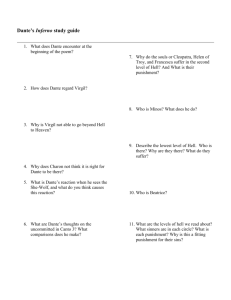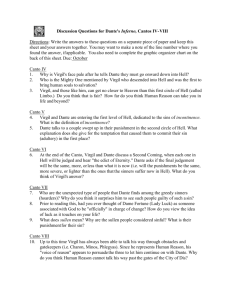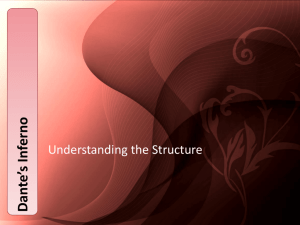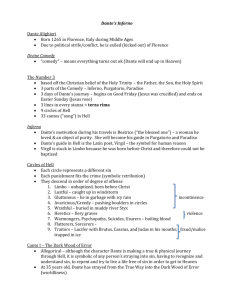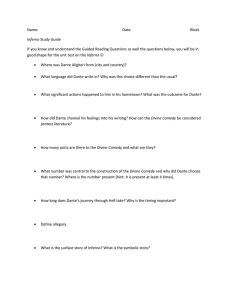AA WORLD HISTORY MIDDLE AGES UNIT
advertisement
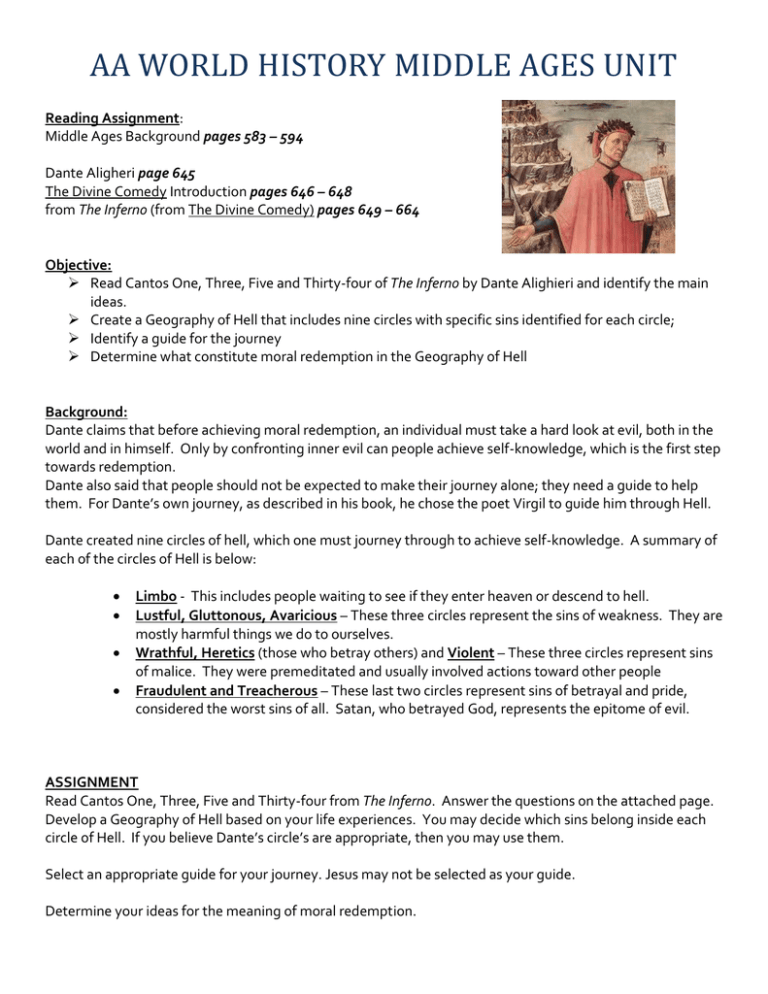
AA WORLD HISTORY MIDDLE AGES UNIT Reading Assignment: Middle Ages Background pages 583 – 594 Dante Aligheri page 645 The Divine Comedy Introduction pages 646 – 648 from The Inferno (from The Divine Comedy) pages 649 – 664 Objective: Read Cantos One, Three, Five and Thirty-four of The Inferno by Dante Alighieri and identify the main ideas. Create a Geography of Hell that includes nine circles with specific sins identified for each circle; Identify a guide for the journey Determine what constitute moral redemption in the Geography of Hell Background: Dante claims that before achieving moral redemption, an individual must take a hard look at evil, both in the world and in himself. Only by confronting inner evil can people achieve self-knowledge, which is the first step towards redemption. Dante also said that people should not be expected to make their journey alone; they need a guide to help them. For Dante’s own journey, as described in his book, he chose the poet Virgil to guide him through Hell. Dante created nine circles of hell, which one must journey through to achieve self-knowledge. A summary of each of the circles of Hell is below: Limbo - This includes people waiting to see if they enter heaven or descend to hell. Lustful, Gluttonous, Avaricious – These three circles represent the sins of weakness. They are mostly harmful things we do to ourselves. Wrathful, Heretics (those who betray others) and Violent – These three circles represent sins of malice. They were premeditated and usually involved actions toward other people Fraudulent and Treacherous – These last two circles represent sins of betrayal and pride, considered the worst sins of all. Satan, who betrayed God, represents the epitome of evil. ASSIGNMENT Read Cantos One, Three, Five and Thirty-four from The Inferno. Answer the questions on the attached page. Develop a Geography of Hell based on your life experiences. You may decide which sins belong inside each circle of Hell. If you believe Dante’s circle’s are appropriate, then you may use them. Select an appropriate guide for your journey. Jesus may not be selected as your guide. Determine your ideas for the meaning of moral redemption. WHAT YOU WILL TURN IN FOR A GRADE Complete answers to the questions over the reading assignment. You will draw your own Geography of Hell on a piece of poster board. You may also do this design on the computer. Write a minimum of two or three paragraphs describing the meaning of each circle and why that circle belongs in Hell, the reason for selecting a particular guide, and an explanation of moral redemption. You may group similar circles into one paragraph. Paragraphs must follow the final draft essay format. This includes blue or black ink, or typed and correct spelling and grammar. Use the essay guidelines distributed in class for the correct format. EVALUATION A six-point rubric will be used to evaluate the poster and written portion of this assignment. 6 – Student through very creatively in developing his/her Geography of Hell, carefully selected an appropriate guide for the journey, and wrote clear, well-constructed descriptive paragraphs. 4 – Student thought creatively in developing his/her Geography of Hell, selected a guide for his/her journey, and wrote adequate, somewhat descriptive paragraphs 2 - Student had difficulty developing his/her Geography of Hell, did not select a guide for his/her journey, and did not complete the descriptive paragraphs 0 – Student did not attempt the assignment. Dante’s Inferno On a separate piece of paper, answer the following questions as you read the Introduction to The Divine Comedy, and The Inferno. Credit will only be given if the answers are written in complete sentences. INTRODUCTION 1. What is symbolic about the journey taken by Dante? 2. What is a canto? 3. Why does The Divine Comedy contain one hundred cantos? 4. What are tercets? Identify the rhyme scheme used in The Divine Comedy. 5. Why is the number three important? 6. Who is Virgil and what is his role in The Inferno? Why did Dante select Virgil to be his guide on his journey? 7. Who is Beatrice? What is her role in The Inferno? CANTO ONE 8. How has Dante ended up in the dark wood? What things in these lines convey the horror and confusion Dante feels in this fearsome place? (Lines 1 -12) 9. What three beasts does Dante encounter? What do they force him to do? (Lines 33 – 60) 10. What line does Virgil appear to Dante? 11. Why is Virgil an appropriate symbol for human reason? (Lines 79 – 87) 12. Why does Virgil counsel Dante to follow him? (Lines 105 – 114) 13. Why might a “worthier spirit” lead Dante into Heaven whereas Virgil cannot? (Lines 115 – 119) CANTO THREE 14. What do you think is the meaning of “division of spirit” in line 14? 15. According to Virgil, what two kinds of souls are found together in lines 32- 36? 16. Why would the souls of the uncommitted be envious of death? (Lines 42-45) 17. In lines 67-72, why does Dante turn his eyes downward and feels ashamed after Virgil’s response? 18. What effect does Charon have on the spirits he leads to shore? How do you know? (Lines 94-99) 19. What causes Dante to swoon (faint)? (Lines 132-134) CANTO FIVE 20. How does a condemned soul learn which circle of Hell he or she will be placed? (Lines 4 – 12) 21. In lines 58 – 67, Dante begins reading from epics about figures known for their sins of passion. What message does Dante intend to convey to the reader by presenting this epic list? 22. What effect did reading about Lancelot have on Francesca and Paolo? What consequences do they suffer as a result? (Lines 124-133) 23. What causes Dante to faint at the end of Canto Five? (Lines 138 – 140) CANTO THIRTY-FOUR 24. According to Dante, what is the final circle of Hell like? (Lines 1 – 12) 25. Why does Dante ask the reader to “imagine for yourself what I became”? (Lines 22 – 27) 26. How many faces does Satan have and what colors are they? What are his wings like? What is his eternal dinner? 27. Who are the three sinners being chewed by Satan? What sin has these greatest of all sinners committed? (Lines 61- 68) 28. In line 84, what are the “stairs” to which Virgil refers? 29. Virgil mentions Christ for the first time in lines 115 – 117. Why do you think he does so at this point in the poem? 30. As Dante and Virgil emerge from Hell, what might the stars symbolize? (Lines 136 – 143)

